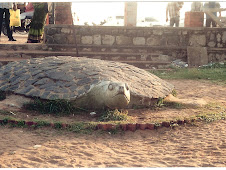On safari in Masai Mara a few years ago, I was treated to a daily wake-up rendition of "Ingonyama nengw' enamabala" by the best part of my life. Thankfully, she did not consider "Chaddi pehan ke phool khila hai" to be as iconic; or maybe it was just that the thought of 45°C while on safari did not make her very songful. Or maybe she considers Rudyard Kipling such an imperialist ass that she has forgotten "The Jungle Book". But she did remember that the forests of Seoni, where Sir William Henry Sleeman discovered a boy brought up by wolves, were the setting for the story of Mowgli. It is difficult to not recall Mowgli; the chaddi pehan ke likeness pops up liberally around the Turia Gate of the Pench Tiger Reserve. That name is kind of shorthand, for the reserve bundles in it the Indira Priyadarshini National Park and the Pench Mowgli Sanctuary. The latter is out of bounds for tourists, but the Mowgli from the animated series can be found in the souvenir shops, the signboards exhorting visitors to be mindful of nature and a few life-size figures that kids try to get photos taken with. They may not know Kipling, but they've taken this Mowgli to be one of their own.
Curious about the etymology of Turia, we checked with one of our guides; according to him, it was the spot from where officials of the British Raj would proceed 'on tour'; the vernacular description of this activity stuck on to become the name of the locality. Turia Gate is the favoured entrance to the Pench Tiger Reserve, accommodating 74 of the 99 vehicles allowed into the core area of the reserve. Despite that, the scene around the gate is quite relaxed. Space to park quite a few vehicles, just a couple of shops selling stuff from fizzy drinks to I-been-to-Pench t-shirts. And some Mowgli stickers. Of course.
One thing to keep in mind is that, in Madhya Pradesh, the forests take a half-day break on Wednesdays. No visitors on Wednesday afternoons. That is the only time you have? Go on to one of the gates on the Maharashtra side of the forest. The nearest such to the Turia gate is the Khursapar gate, 12 km away. But if you do end up at Turia gate on a Wednesday afternoon, do yourself a favour, and drive the extra 40 km to Sillari gate, which is said to be the best on the Maharastra side. Our experience going through Khursapar will become one of those suppressed, traumatic memories. It was likely an off day for all of us, the visitors, the guide, the driver, and maybe the animals there as well. The one thing I remember - faintly - from that safari is that we had a female guide. She was one of the 20-odd ladies who have been authorised to work as guides at Pench, something I haven't seen at any of the other National Parks I've been to. So that was a first; I hope it does not remain unique over the next few years.
Getting in through the Turia gate, you will be assigned one of three routes; one towards the Baginalla waterhole, another which takes you to open central lands and the third towards rocky terrain going up to Kalapahad, the highest point within the Reserve.
It all sounds well to say it like this, but I have no clue how many times we went along each of those routes. After a couple of safaris, some of the points became familiar - like the communal waterhole from where one has to turn right to arrive at the nest of the Malabar Pied Hornbill. At the waterhole itself, we knew where to look for the mongoose, to peer up at the Hanuman Langur kiddos showing off their swinging prowess or to watch out for the flocks of Red Jungle Fowl, the males having an unusual circular white patch behind their beaks. (Unusual when first observed; learnt much later that such a patch - a lappet - is usual enough for this subspecies, the Gallus gallus murghi).
Other locations became routine. The MP Forest Department has an elephant camp at Alikatta, inside the core area. There was a village here once, which was relocated when the area became part of the tiger reserve. The five elephants working for the Department are as domesticated as can be; their staple breakfast is stuffed roti, about 8-10 for each elephant. Not to worry, these are slightly bigger than the ones landing up on your breakfast table and the elephants do get other munchies as well.
Alikkata seems to be the place to get stuffed. It is where the safari vehicles congregate for breakfast. Sometime during the first safari of our trip, messages came from veteran Pench-folk: "Don't miss the alu bonda at Alikatta!", they exhorted. We didn't.
Were you here looking for descriptions of the wildlife itself? Oh, for that, you're better off reading this from DamVilRam, seeing pictures from Suresh here, or from Arul, here. If you insist on seeing photos that I took, go here - has a couple of tiger videos, too!












